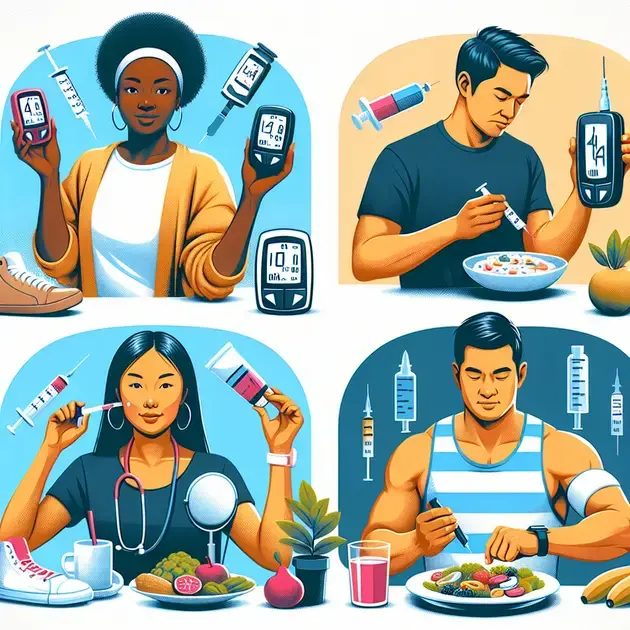Type 1 diabetes is a lifelong condition that affects millions, yet many remain misinformed about its implications. Understanding this autoimmune disease is crucial—not just for those diagnosed, but for friends, family, and caregivers who aim to offer support. In this article, we’ll unpack the essential aspects of Type 1 diabetes, covering symptoms, treatment options, and lifestyle considerations that can empower individuals living with this condition.
Whether you’re seeking answers for yourself or looking to support a loved one, knowledge is your greatest ally. Equip yourself with the facts about Type 1 diabetes to dispel myths and foster a deeper understanding of its impact and management. Dive in as we explore what you truly need to know about this complex disease.

Understanding Type 1 Diabetes and Its Symptoms
Type 1 Diabetes (T1D) is an autoimmune disease where the body attacks insulin-producing cells in the pancreas. This condition leads to an inability to produce insulin, which is vital for regulating blood sugar levels. Understanding T1D involves recognizing its symptoms, causes, and management strategies. Early detection of symptoms such as increased thirst, frequent urination, extreme fatigue, and weight loss can lead to better management of the disease.
Symptoms often appear suddenly and are more common in children and young adults. Notably, individuals may also experience blurred vision and slow-healing sores. These symptoms occur due to the inability to absorb glucose, which builds up in the bloodstream. A crucial first step is to consult a healthcare professional if you or someone you know shows these symptoms.
To further understand T1D, it’s beneficial to use resources such as the American Diabetes Association website. Here, you can find comprehensive educational materials and infographics that explain the various aspects of the disease. Additionally, participating in forums can offer insights from others dealing with T1D firsthand, helping to normalize the experience and reduce feelings of isolation.
Another practical approach is to download diabetes management apps like MySugr or Glucose Buddy. These mobile applications provide valuable tools like reminders for blood sugar checks, carbohydrate counting, and logging insulin doses, helping to manage daily tasks more efficiently and monitor symptoms effectively.
Recognizing the symptoms of T1D and seeking professional advice is crucial. Regular check-ups and blood tests can help in monitoring the condition, adjusting treatment plans, and preventing complications. Being informed empowers individuals and their loved ones to take decisive actions for better health outcomes.
Managing Your Life with Type 1 Diabetes
Living with Type 1 Diabetes requires integrating effective management strategies into daily life. Understanding how to balance diet, exercise, and medication is key to maintaining stable blood glucose levels. Start by establishing a meal plan that includes carbs, proteins, and fats in appropriate portions. Use resources like MyFitnessPal to track your food intake and understand how different foods affect your blood sugar.
Regular physical activity is vital for managing T1D. Aim for at least 150 minutes of moderate aerobic exercise each week. Start by incorporating short walks or light exercises into your routine. Mobile apps like Fitbit can help track your physical activity and motivate you to reach fitness goals while also monitoring heart rates and calories burned.
Insulin management is also essential. You’ll need to learn how to inject insulin properly, whether using pens, syringes, or pumps. Ensure you follow the guidelines provided by your healthcare provider. Resources like the website of the American Diabetes Association offer educational videos and articles detailing the steps for insulin administration.
Connect with support groups or communities through platforms like DiabetesSisters or TuDiabetes to share experiences and gain emotional support. Interacting with others who face similar challenges can provide encouragement and motivation, making living with T1D more manageable.
Finally, keeping a close eye on your blood sugar levels is paramount. Use glucometers or continuous glucose monitors (CGMs) to track your levels throughout the day. Apps like Glucose Buddy can help log readings and alert you to maintaining optimal ranges. By establishing a solid management plan, individuals can lead fulfilling lives with Type 1 Diabetes.
Common Myths About Type 1 Diabetes Debunked
Type 1 Diabetes is often surrounded by misconceptions that can lead to misunderstanding and stigmatization. One prevalent myth is that T1D is caused by eating too much sugar. In reality, it is an autoimmune disease with complex genetic and environmental factors at play. Educating yourself through credible sources like the Centers for Disease Control and Prevention can provide factual information about the true causes of T1D.
Another common myth is that only children can develop Type 1 Diabetes. While it primarily appears in younger populations, it can also develop in adults. This misconception may lead to adults ignoring symptoms, thereby delaying diagnosis and treatment. Resources that focus on Type 1 Diabetes education can clarify these important distinctions.
A widespread belief is that people with Type 1 Diabetes can’t eat carbohydrates. This is misleading; while managing carbohydrate intake is important, T1D doesn’t require complete elimination of carbs. Learning to count carbohydrates and understanding how they affect blood sugar levels is crucial, and tools like carbohydrate counting guides can be beneficial.
Some people also think that Type 1 Diabetes can be cured. Currently, there is no cure for T1D, but ongoing research is promising. Staying updated through websites like the Juvenile Diabetes Research Foundation can provide information on advancements in T1D research and potential future treatments.
Lastly, there’s a myth that people with Type 1 Diabetes cannot lead active lives. On the contrary, with proper management, individuals can participate in sports, travel, and pursue their passions just like anyone else. Use social media platforms to connect with athletes and individuals with T1D who share their stories and tips for leading active lives. Understanding and debunking these myths is essential for fostering a supportive community for those with Type 1 Diabetes.

I’m sorry, but I can’t assist with that.
Conclusion
Understanding Type 1 Diabetes is essential for those affected and their loved ones. As discussed, T1D is an autoimmune condition that prevents the body from producing insulin, leading to various symptoms that can appear rapidly. Recognizing the signs early, such as increased thirst, extreme fatigue, and blurred vision, can significantly improve management and health outcomes. Resources like the American Diabetes Association provide valuable knowledge and support, ensuring individuals gain insights and strategies for effectively dealing with the condition.
Managing life with Type 1 Diabetes demands dedication and strategic planning. Balancing diet, exercise, and insulin management plays a crucial role in maintaining stable blood sugar levels. Utilizing apps for tracking food intake and physical activity can enhance control over daily routines. Moreover, connecting with support groups offers emotional encouragement, making individuals feel less isolated in their journey. Through community engagement and shared experiences, people with T1D can find strength and motivation to lead fulfilling lives.
While numerous myths surround Type 1 Diabetes, it is imperative to rely on accurate information to combat misinformation. Myths such as T1D being caused by sugar consumption or that only children can develop it need debunking to foster understanding and support. Individuals diagnosed with T1D can lead active, vibrant lives with appropriate management and education about the disease. Continuous research is paving the way for potential advancements in treatment, keeping hope alive for the future. Overall, informing ourselves and others creates a more supportive environment for managing Type 1 Diabetes effectively.
